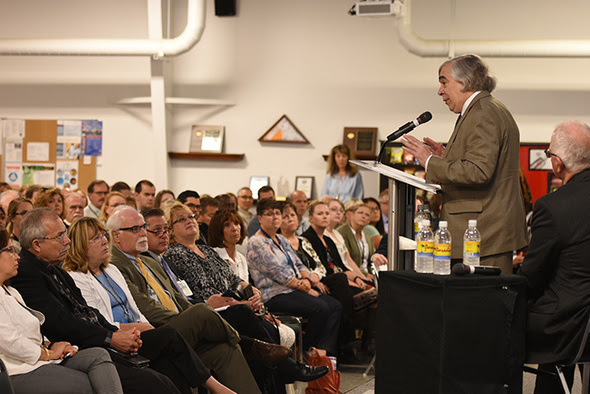Secretary Moniz, Assistant Secretary Regalbuto Visit Hanford
Energy Secretary Ernest Moniz talks with Hanford Site employees.
RICHLAND, Wash. – Energy Secretary Ernest Moniz and EM Assistant Secretary Monica Regalbuto visited the Hanford Site
in mid-August to view firsthand the worker training programs and
Hanford’s tank farms operations. They received briefings on cleanup
projects and participated in meetings and activities with employees,
labor leaders, tribal representatives and community members.
Together they observed demonstrations at the EM Richland Operations Office’s Volpentest Hazardous Materials Management and Emergency Response (HAMMER) Federal Training Center, which Moniz described as a best practice to be replicated across the DOE complex that provides high-quality, cost-effective training, and reduces redundancies across the DOE complex.
“This is an impressive state-of-the-art facility,” Moniz said,
referring to HAMMER during a Hanford employee meeting. “I met a number
of your worker-trainers instructing employees on how to safely and
successfully complete the extremely challenging and hazardous work that
takes place at Hanford.”
After the employee meeting, Moniz and Regalbuto visited the AP Tank
Farm, receiving a briefing on new vapors technologies that are aimed to
provide additional data and increased protection for workers. They then
toured a multi-tank farm control room where the contractor’s staff
monitors cameras and sensors in real time.
After their tour, both joined in an open-dialogue discussion with all
four tribes with Hanford Site interests: the Wanapum, Nez Perce, Yakama
Nation and Confederated Tribes of the Umatilla Indian Reservation. The
meeting focused on issues important to those tribes at the site.

Karthik
Subramanian, far left, chief engineer with EM contractor Washington
River Protection Solutions, explains to Energy Secretary Ernest Moniz
and EM Assistant Secretary Monica Regalbuto a piece of equipment used to
monitor toxic gases, oxygen and combustible gases in hazardous
environments at the Hanford tank farms.

Jason
Young, federal project director for the Waste Treatment and
Immobilization Plant balance of facilities and analytical laboratory,
briefs EM Assistant Secretary Monica Regalbuto at the analytical
laboratory during her visit to the facility.

Outfitted
in protective clothing while touring a former chemical engineering
laboratory that was previously highly contaminated, EM Assistant
Secretary Monica Regalbuto, right, enjoys a discussion with April
Wickersham, operations manager for cleanup of the laboratory, known as
the 324 Building, for EM contractor CH2M HILL Plateau Remediation
Company.

Richland
Operations Office Manager Doug Shoop points out tribal revegetation
projects south of the 300 Area on the Hanford Site to EM Assistant
Secretary Monica Regalbuto while Wanapum leader Rex Buck, Jr., looks on.
The EM office and its contractor recently removed debris and will be
revegetating this area of importance to the Wanapum.
Regalbuto also met with Wanapum leader Rex Buck, Jr., to discuss waste
sites and tribal revegetation projects of significance to the tribe
near Hanford’s 300 Area.
Moniz and Regalbuto also met with leaders of the local labor union and
talked with Hanford Site employees before Regalbuto toured the Waste Treatment and Immobilization Plant (WTP).
There, she saw the progress being made on the Low-Activity Waste (LAW)
Facility, Analytical Laboratory and balance of facilities. The LAW
Facility and Analytical Laboratory are both on their way to completion,
and the nearly two-dozen buildings that make up the balance of
facilities will provide support services to WTP are either complete or
nearing completion.
She also observed a document scanning-and-indexing operation performed by local college students, and toured the 324 Building,
which sits atop a highly contaminated waste site and remains one of the
most important cleanup projects remaining on the Columbia River
corridor.
Later in her visit, Regalbuto visited the Richland-based Mid-Columbia
Engineering, where an engineered scale-test facility recently began its
startup phase to integrate the filtration and ion exchange systems for
the Low-Activity Waste Pretreatment System (LAWPS) and confirm the
technologies involved. The LAWPS facility is a key part of EM's Office of River Protection
plan to start vitrifying low-activity waste as soon as 2022, which
means turning it into a stable glass form for final disposition.
“The people that I met and the projects that I visited are some of the
finest in all of EM. They’re dedicated to working safely and to
completing all of the challenging work ahead, while rightfully proud of
all they have done,” Regalbuto said.
|

No comments:
Post a Comment